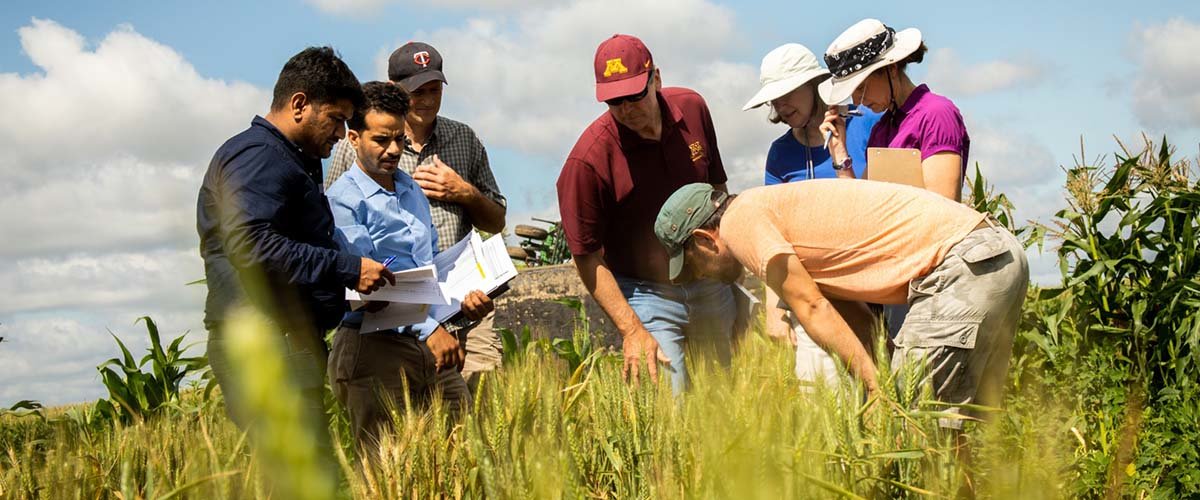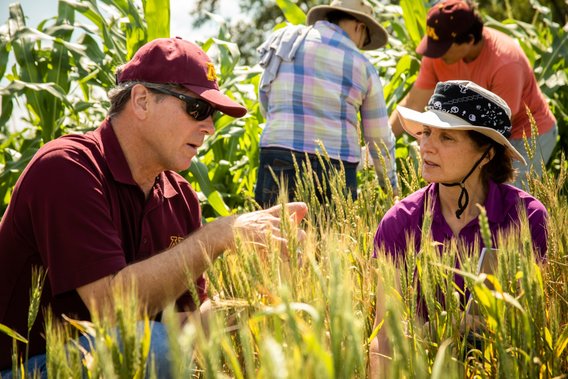
Busting rust, boosting food security with resistance gene cassettes in wheat

University of Minnesota field testing of transgenic wheat lines shows enhanced resistance to stem and leaf rust
When the average consumer takes a bite of a sandwich or scoops up a spoonful of cereal, they may not realize that the essential grain they’re enjoying — wheat — supplies approximately 20 percent of the caloric intake for humans globally. It also is an ancient grain, tracing its origin to the Fertile Crescent some 10,000 years ago. Today, wheat is grown around the world on 215 million hectares, an area equivalent to the size of Saudi Arabia, and is consumed by 2.5 billion people in 89 countries.* In Minnesota alone, farmers grow about 1.5 million acres of wheat each season.
With wheat playing a key role in ensuring global food security, it is critical for farmers to control the rusts and fungal diseases that can completely destroy crops over a wide area in just a few weeks. Wheat rust, so named for its characteristic orange pustules resembling iron oxidation, can infect the plant’s stems and leaves, causing severe losses in both the yield and quality of grain. Throughout the centuries — as far back as ancient Rome — the rusts have caused famines and ruined economies. In the U.S, the Upper Midwest region suffered devastating epidemics of wheat stem rust in the early 1900s, 1930s and 1950s. Breeding wheat varieties with resistance is one of the best means of controlling the rust diseases.
However, these shifty rust pathogens are constantly mutating, leading to the emergence of new races capable of overcoming the resistance genes bred into wheat. While great success has been attained in keeping stem rust from damaging wheat for over 60 years in the Upper Midwest, there exist highly virulent races of the fungus in Africa that can destroy over 80 percent of the world’s wheat varieties. These virulent races have caused recent epidemics on wheat in several African countries and threaten global food security if they spread to the major production areas of India, Pakistan, China, Australia, South America and the U.S.
“Stacking” genes to bust the rust
Brian Steffenson, a professor in the Department of Plant Pathology at the University of Minnesota College of Food, Agricultural and Natural Resource Sciences (CFANS), and Lieberman-Okinow Endowed Chair of Cereal Disease Resistance, has co-authored a paper entitled “A five-transgene cassette confers broad-spectrum resistance to a fungal rust pathogen in wheat” published this week in Nature Biotechnology.
At CFANS, Steffenson’s main research focuses on disease resistance in cereal crops, genetic diversity in wild crop progenitors, and virulence diversity in plant pathogenic fungi. In his role as the Lieberman-Okinow Endowed Chair, his primary mission is to identify and utilize genes from wild species to improve disease resistance in wheat, barley, oat and rye.
In partnership with lead researchers at the Commonwealth Scientific and Industrial Research Organization in Australia, Aarhus University in Denmark, John Innes Centre in the United Kingdom, United States Department of Agriculture, and with funding from The 2Blades Foundation, Steffenson worked to develop wheats with a stronger, broader, and potentially more durable level of resistance against rust pathogens, including highly virulent ones from Africa.
The research team selected five different rust resistance genes isolated from wheat, wild wheat species, and rye and assembled them together in a single “cassette” that was introduced into a susceptible wheat cultivar called “Fielder” by genetic engineering. The beauty of this technology is that one can efficiently transform a susceptible wheat variety into a resistant one in less than a year without major disruptions to the rest of the genome. Moreover, the five resistance genes assembled into the cassette will stay together as a single genetic unit, thereby simplifying the breeding process for rust resistance. This is a major advance over conventional wheat breeding where individual resistance genes are added one by one using various hybridization techniques, a laborious process requiring many years of crossing and intense selection.
This novel approach of building multiple layers of protection will make it much harder for rust pathogens to successfully attack wheat, explains Steffenson, noting the possibility of constructing multi-gene cassettes with up to seven genes in the future. “Transferring a cassette of multiple resistance genes into wheat is like installing many burglar alarms in a house,” said Steffenson. “A burglar may be clever enough to avoid detection by one alarm, but not all of them. Even if just one alarm is sounded for an invading pathogen, the plant will activate its defense responses to halt further infection.”
Preliminary greenhouse experiments on seedling plants of the transformed Fielder wheat plants were very promising as all were highly resistant to the most widely virulent races of the stem rust pathogen, including those from Africa. The acid test, however, was how the wheat plants with the resistance gene cassette would perform in the field.
Results from the field
While a lot of work went on in the labs of the international research team, Steffenson spent much of his time outside. “I think my role was particularly gratifying because I was able to see first-hand how well the gene cassette worked in conferring stem rust resistance in wheat under field conditions,” he said.
In 2018 and 2019, Steffenson and his team planted test plots of the experimental wheats in Minnesota in May and then spray-inoculated them with the stem rust pathogen in late June and early July. Thereafter, the plants were evaluated weekly for their resistance to the disease.
“The results of the field tests were quite extraordinary as no stem rust rust pustules were found on any of the transgenic lines over the two years of the trial,” said Steffenson. In contrast, the susceptible wild type control of Fielder had disease infection ranging from 60 percent to over 95 percent. “Our next phase of research will be testing the transgenic wheat lines in Africa and other places of the world where stem rust is a problem,” he said.
One of the five resistance genes in the cassette was reported to confer partial field resistance to all three wheat rust diseases: stem rust, leaf rust, and stripe rust. Steffenson’s field test also confirmed leaf rust resistance in the experimental wheats with trials for stripe rust scheduled in 2021. “The potential for controlling the ‘rust disease trifecta’ with resistance gene cassettes would be a major breakthrough in wheat breeding. This technology will not only provide a means for protecting wheat from rust diseases, but potentially many other crops from the array of different diseases attacking them,” said Steffenson.
Looking to the future, he said, “We will continue to identify and clone additional disease resistance genes that can be assembled into new cassettes for transfer into wheat. It is my hope that this breeding strategy will reduce the threat of rust diseases worldwide and help contribute to food security.”
Building on Borlaug’s work
Steffenson says that this ground-breaking research builds on the wheat breeding legacy of the late Norman Borlaug, who earned all three of his academic degrees at the University of Minnesota and is recognized as the Architect of the Green Revolution. While based in Mexico with the Rockefeller Foundation, Borlaug won the Nobel Peace Prize in 1970 for developing high yielding, disease resistant wheats that saved hundreds of millions of people from starvation in South Asia.
“Rust diseases were Borlaug’s constant nemesis in wheat breeding,” said Steffenson. “If a new technology was proven to be safe and effective for controlling plant diseases, Borlaug would be a strong advocate for bringing it to the farmer.”
Photo credit: Grant Czadzeck, Department of Plant Pathology
*CGIAR Research Program on Wheat







